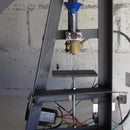Introduction: Basic Watch Pressure Tester.
This is a basic pressure tester for watches which uses water to check for leaks.
I used a car tyre inflater connected to my compressor, but there are other ways of doing it.
Supplies
,I used:
- Mild steel flat bar 6mm thick, 50mm wide, 83mm long x2.
- Clear acrylic tube 50mm dia, 150mm long.
- M8 threaded rod190mm, x2.
- M8 washers and wingnuts x2 both.
- Schrader valve for tubeless rims and core tool.
- Car tyre inner tube for top and bottom gaskets.
NB the inner dia of the tube is 42mm, so you need to consider that when sourcing a tube for your particular watch.
Tools were, drill press, angle grinder, hacksaw, welder and wet/dry sandpaper.
Step 1: Top and Bottom Plates.
I used 6mm mild steel.
Top plate has a 15mm dia hole for the valve which was a bit of a loose fit, 14mm might be better.
Two holes were drilled for the watch hanger(2.5mm welding rod with flux removed) which was then welded shut on the upper side.
Both plates were clamped together and drilled for the threaded rod.
Bottom plate holes were tapped for M8 threaded rod.
Step 2: Testing the Device.
First step after assembly is to test the chamber for leaks.
I filled it up halfway with filtered water, added through the Schrader valve, with a basting syringe from the kitchen and pumped it up to 700kpa(101psi) with no leaks.
A safer option would be to fill it up all the way with water, then if anything breaks there will be no shrapnel from pieces flying out, just a wet mess.
Step 3:
After installing the watch and filling halfway with water, pressurize the container and allow it to sit for 3min to allow the pressure inside the watch to equalize with the chamber.
Im using my Seiko 5 auto,7S26 0ED0 which is 37mm in diameter and is only "water resistant", so Im using 1 bar of pressure, ie 100kpa.
Next release the pressure slowly with the watch still above the water, dont use the valve on the inflater to dump the pressure because that can cause the watch glass to pop off. On this watch there is a clear glass on the back as well.
Now turn the chamber upside down so that the watch is submerged in water and check for leaks.
They will manifest as a small stream of bubbles from either the crown( winder) perimeter of the glass or the case back.
If you spot leaks, immediately turn the chamber right side up to prevent water entering the watch and empty the chamber.
Small bubbles in trapped air spaces is normal as in the last 2 pics.
After testing at 100kpa, I then tested at 200kpa which was the highest I was prepared to risk as the watch only has a water resistant rating.
It passed both tests, so Im happy.
Although I had everything bar the wingnuts and washers, it shouldn't cost more to put together than a pressure test at the jewelers.
For info, I recently had a Seiko chronograph 7T92 quartz watch tested which cost 90ZAR here in South Africa.
That watch has a 10bar/100m water proof rating which was far higher than the safety valve on the compressor tank which releases at 800kpa.













